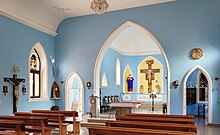| St. John the Baptist Church | |
|---|---|
Avliyo Ioann Baptist cherkovi | |
 | |
 | |
| 39°38′47″N 66°57′18″E / 39.6464°N 66.9550°E | |
| Location | Samarkand |
| Country | |
| Denomination | Roman Catholic Church |
The St. John the Baptist Church[1] is the only Catholic church in the city of Samarkand,[2] Uzbekistan.[3] It depends on the Apostolic Administration of Uzbekistan based in Tashkent.
History[edit]
In the times of the Russian Empire in the nineteenth century a small Catholic minority in Samarkand formed by merchants and employees of Polish or German origin settled in the place. They asked permission to build a church in 1905, but were denied. In 1915 a number of Polish prisoners of war (originating in Poland, Prussia and Austria) were added, so it was possible that the Catholic community could build his church. They bought the land in the present street Makhmud Kochgari. Neo-Gothic church was built by architect Nelle - and was completed in 1916. It was closed by the authorities of the Uzbek Soviet Socialist Republic in 1930; to install a school.

In 1995, at the initiative of Father Ivan Rolloff the Catholic community of the city obtained permission to officially register and recover the building in 1997. After restoration work, the church is dedicated on March 27, 1999.
Today the community is run by a Polish priest, Father Luciano Szymanski assisted by two brothers of a Polish Franciscan monastery.
See also[edit]
References[edit]
- ^ «Samarkand Christian Temples :: Info about Samarkand Christian Temples»
- ^ "Христианские храмы Самарканда :: Церкви и храмы Узбекистана". orexca.com. Retrieved 2016-05-15.
- ^ "Bestatour.org - Tours in Central Asia". bestatour.org. Retrieved 2016-05-15.

Well, that’s interesting to know that Psilotum nudum are known as whisk ferns. Psilotum nudum is the commoner species of the two. While the P. flaccidum is a rare species and is found in the tropical islands. Both the species are usually epiphytic in habit and grow upon tree ferns. These species may also be terrestrial and grow in humus or in the crevices of the rocks.
View the detailed Guide of Psilotum nudum: Detailed Study Of Psilotum Nudum (Whisk Fern), Classification, Anatomy, Reproduction